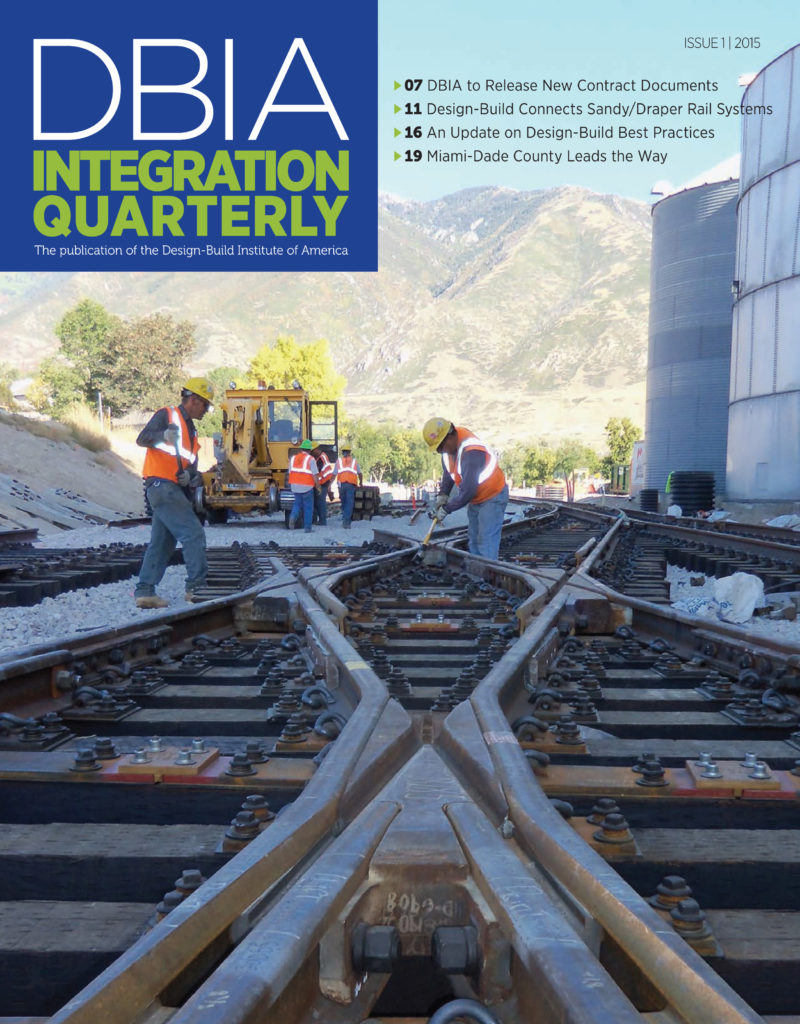DBIA conducts the most comprehensive research on the design-build methodology. Scroll down to get access to our most popular reports.
An important update to the seminal 1998 CII/Penn State cost and schedule research shows design-build continues to deliver projects faster and with greater reliability in cost and schedule performance. Funded by CII/Pankow.
The most detailed design-build market research in years was conducted by FMI and found design-build will account for nearly half of construction spending in the assessed sectors (highway/street, water/wastewater and nonresidential) by 2021, with a growth rate of 18% during that same window.
Joint research by the Water Design-Build Council and DBIA analyzes data collected on water projects nationwide to provide historical and prospective trends for design-build contracting by geographic region and by project type including water treatment, wastewater treatment, wastewater collection, water conveyance and stormwater management.
The transportation sector’s use of design-build has outpaced every other market sector — and it’s still growing. In December 2015, DBIA surveyed DOT Owners to find out how many design-build projects their department had completed, and the results show a more than 600% increase since FHWA’s survey in 2002.
Findings from a robust empirical study of more than 200 capital facility projects revealed that owners should consider an overall project delivery strategy when structuring design and construction services, rather than focusing exclusively on the delivery method. In particular, the study finds that those strategies which align the core project team — Owner, designers, primary builder and key specialty trades — are more effective in meeting or exceeding goals related to cost, schedule and quality. Additional related documents include:
Research Report: Examining the Role of Integration in the Success of Building Construction Projects
Report FAQs
Report Questionnaire
This study is based on the presumption that design and construction is an imperfect process with a variety of inherent uncertainties. The study aimed to help project teams identify, anticipate and mitigate the conditions and factors driving that uncertainty, so that Owners might adjust their expectations of project team performance accordingly.
Research reveals that while Owners, architects and contractors in the buildings sector all agree that the choice of a delivery system impacts project cost, schedule, and client satisfaction, perspectives on which of the three established delivery systems can best deliver these and other benefits often vary widely by player.
The results of a study conducted by RSMeans on the growing use of design-build indicate that for the first time more than half of projects above $10 million are being completed through design-build project delivery. The study also confirms that the use of design-build has remained steady since its growth spurt at the end of the last decade, and also that Oregon and the Military sector lead the nation in design-build expenditures.
This report illustrates how project-delivery methods help achieve sustainable, high-performance building projects. The findings are synthesized from a two-year study that collected data through 230 surveys, 92 procurement documents and 12 in-depth case studies.
Mortenson Construction surveyed design-build industry leaders at the 2010 Design-Build Conference and Expo and compiled their responses regarding the state of the industry.
Researchers sought to determine the effect of delivery methods and practices on the level of integration achieved in projects, and the repercussions of integration levels on the outcomes of projects emphasizing sustainability goals. The report supplements and validates research that produced the previous report. It consists of 12 in-depth case studies of the project delivery phase and compared them with building performance at project completion.
This study of delivery systems found that design-build offers equal or higher quality than other commonly used delivery methods. The main findings are that, compared to the traditionally used design-bid-build, design-build delivers projects with an average 6% cost savings, 12% faster construction speed, and 33% faster overall project delivery. In fact, design-build outperformed design-bid-build in every category on a 10 point scale.


